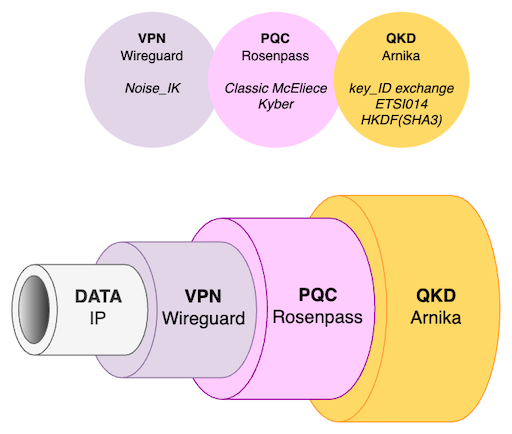In its most complex showcase outside its home network in Vienna, the KMS performed and supported a remarkable demo setup at the QCI-Days Athens 2025. Together with the engineers of HellasQCI and EuroQCI Spain, a complex QKD Network was showcased featuring different applications and technologies, across three domains.
The overall setup was three disjoint QKD Networks, an Austrian, a Greek and a Spanish network. Alongside use-cases on the individual domains, an inter-domain use-case was showcased, mainly supported by the ETSI GS QKD 020 implementation of QoolNet. The inter domain use-case was a layer 3 encryptor by Fortinet, that obtained the keys through a normal ETSI GS QKD 014 interface to establish a secured channel that showcased a video call. This video-call had a participant in the Austrian, Greek and Spanish domain.

With the Austrian domain, the AIT KMS showcases using the CV-QKD devices by KEEQuant for one link and as a premiere the DV-devices by QTI. While the devices are also used in the QCI-CAT project, for this occasion the team thanks the two companies for lending a link each. This resulted in a 3 node setup in the AT domain, where the KMS performed key distribution according to the applications needs.

A novelty for the KMS was showing the ETSI GS QKD 014 specified group key feature. This enables multiple users to share the same key. In this showcase the chat and video application Jitsi was modified by the QCI-CAT partners X-Net, to support QKD key usage on the client, so no additional link encryptor is needed to support quantum safe video and chat applications. This use-case showcased the group key feature, since one video call participant was on the first node and two others on the second node, but all of them had to obtain the same key, which was managed by the KMS.

The second use-case was a Wireguard VPN, that was using PQC keys and QKD keys supported by the open source extension Arnika written by the QCI-CAT partners Cancom. This VPN then showcased securing sensitive data. For this an HSM storing fictional sensitive data, such as Keys or certificates, was deployed on the first node, while a backup device was deployed on the third node. The HSMs used the VPN secured channel to backup the data.

As noted, the Austrian domain was part of a multi domain network, with the Greek network being the largest with 5 nodes, notably connecting from the venue to the different nodes in the Greek QKD network. They showcased different commercial encryptors each using a different technology, encrypting on layer 1, 2 or 3 respectively. The QKD layer was composed of ThinkQuantum and IDQ devices. They further showcased different KMS vendors from QoolNet, EvolutionQ and IDQ. A monitoring software developed within the HellasQCI Project was performing monitoring tasks for critical KPIs.
The Spanish domain consisted of 3 nodes, the QKD layer was also composed of ThinkQuantum and IDQ devices. They mainly showcased the QoolNet technology of KMS and network management. Their biggest contribution is, that they also integrated into the Greek and Austrian domain to enable the multi-domain end-to-end QKD key provision.
This dissemination showcase was possible due to the research in the projects: QCI-CAT, Quarter, eCAUSIS, PETRUS.
